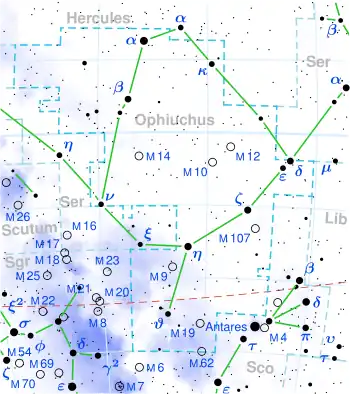| Observation data Epoch J2000 Equinox J2000 | |
|---|---|
| Constellation | Ophiuchus |
| Right ascension | 17h 25m 45.23266s[1] |
| Declination | +02° 06′ 41.1208″[1] |
| Apparent magnitude (V) | 7.492[2] |
| Characteristics | |
| Spectral type | K7V[2] |
| U−B color index | 1.261[2] |
| B−V color index | 1.373[2] |
| Astrometry | |
| Radial velocity (Rv) | −24.4[3] km/s |
| Proper motion (μ) | RA: −579.66[1] mas/yr Dec.: −1,184.76[1] mas/yr |
| Parallax (π) | 129.6459 ± 0.0175 mas[4] |
| Distance | 25.157 ± 0.003 ly (7.713 ± 0.001 pc) |
| Absolute magnitude (MV) | 8.06[2] |
| Details | |
| Radius | 0.564[5] R☉ |
| Surface gravity (log g) | 4.70[6] cgs |
| Temperature | 4,030[5] K |
| Metallicity [Fe/H] | −0.20[6] dex |
| Rotation | 11.94 days[7] |
| Age | (205 ± 21) × 106[7] years |
| Other designations | |
| Database references | |
| SIMBAD | data |
 Gliese 673 Location of Gliese 673 in the constellation Ophiuchus | |
Gliese 673 is an orange dwarf star in the constellation Ophiuchus. It has a stellar classification of K7V.[2] Main sequence stars with this spectra have a mass in the range of 60–70% of solar mass (M☉) (comparable to the members of the binary star system 61 Cygni).
This star is relatively near the Sun at a distance of about 25 light-years. In spite of this proximity, however, it is still too faint to be viewed by the unaided eye. It is considered a slowly rotating star with a relatively high proper motion.
Gliese 673 is among nearby K-type stars of a type in a 'sweet spot' between Sun-analog stars and M stars, in terms of the likelihood of life and its ease of detectability (in this case for planets in the system's outer conservative habitable zone), per analysis of Giada Arney from NASA's Goddard Space Flight Center.[9]
See also
References
- 1 2 3 4 van Leeuwen, F. (November 2007), "Validation of the new Hipparcos reduction", Astronomy and Astrophysics, 474 (2): 653–664, arXiv:0708.1752, Bibcode:2007A&A...474..653V, doi:10.1051/0004-6361:20078357, S2CID 18759600
- 1 2 3 4 5 6 Koen, C.; et al. (April 2010), "UBV(RI)C JHK observations of Hipparcos-selected nearby stars", Monthly Notices of the Royal Astronomical Society, 403 (4): 1949–1968, Bibcode:2010MNRAS.403.1949K, doi:10.1111/j.1365-2966.2009.16182.x
- ↑ Nordström, B.; et al. (May 2004), "The Geneva-Copenhagen survey of the Solar neighbourhood. Ages, metallicities, and kinematic properties of ˜14 000 F and G dwarfs", Astronomy and Astrophysics, 418: 989–1019, arXiv:astro-ph/0405198, Bibcode:2004A&A...418..989N, doi:10.1051/0004-6361:20035959, S2CID 11027621
- ↑ Brown, A. G. A.; et al. (Gaia collaboration) (2021). "Gaia Early Data Release 3: Summary of the contents and survey properties". Astronomy & Astrophysics. 649: A1. arXiv:2012.01533. Bibcode:2021A&A...649A...1G. doi:10.1051/0004-6361/202039657. S2CID 227254300. (Erratum: doi:10.1051/0004-6361/202039657e). Gaia EDR3 record for this source at VizieR.
- 1 2 van Belle, Gerard T.; von Braun, Kaspar (April 2009), "Directly Determined Linear Radii and Effective Temperatures of Exoplanet Host Stars", The Astrophysical Journal, 694 (2): 1085–1098, arXiv:0901.1206, Bibcode:2009ApJ...694.1085V, doi:10.1088/0004-637X/694/2/1085, S2CID 18370219
- 1 2 Frasca, A.; et al. (December 2009), "REM near-IR and optical photometric monitoring of pre-main sequence stars in Orion. Rotation periods and starspot parameters", Astronomy and Astrophysics, 508 (3): 1313–1330, arXiv:0911.0760, Bibcode:2009A&A...508.1313F, doi:10.1051/0004-6361/200913327, S2CID 118361131
- 1 2 Barnes, Sydney A. (November 2007), "Ages for Illustrative Field Stars Using Gyrochronology: Viability, Limitations, and Errors", The Astrophysical Journal, 669 (2): 1167–1189, arXiv:0704.3068, Bibcode:2007ApJ...669.1167B, doi:10.1086/519295, S2CID 14614725
- ↑ "LHS 447 -- High proper-motion Star", SIMBAD, Centre de Données astronomiques de Strasbourg, retrieved 2011-10-15
- ↑ Arney, Giada N. (2019). "The K Dwarf Advantage for Biosignatures on Directly Imaged Exoplanets". The Astrophysical Journal. 873 (1): L7. arXiv:2001.10458. Bibcode:2019ApJ...873L...7A. doi:10.3847/2041-8213/ab0651.
External links